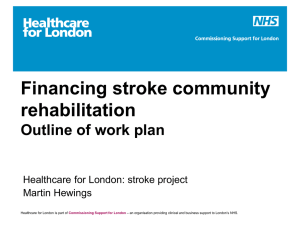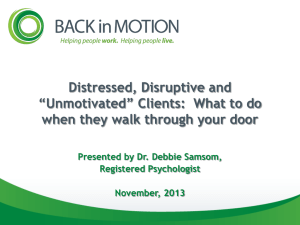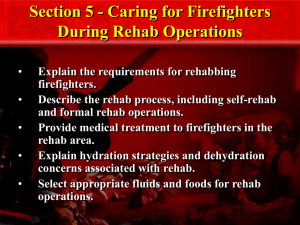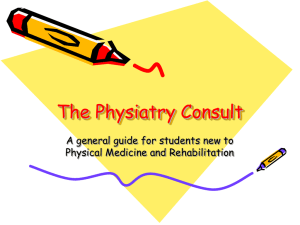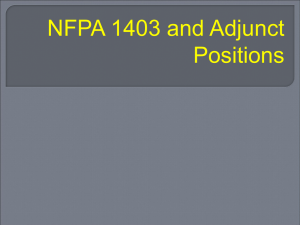Rehab Revised - Mike McEvoy.com
advertisement
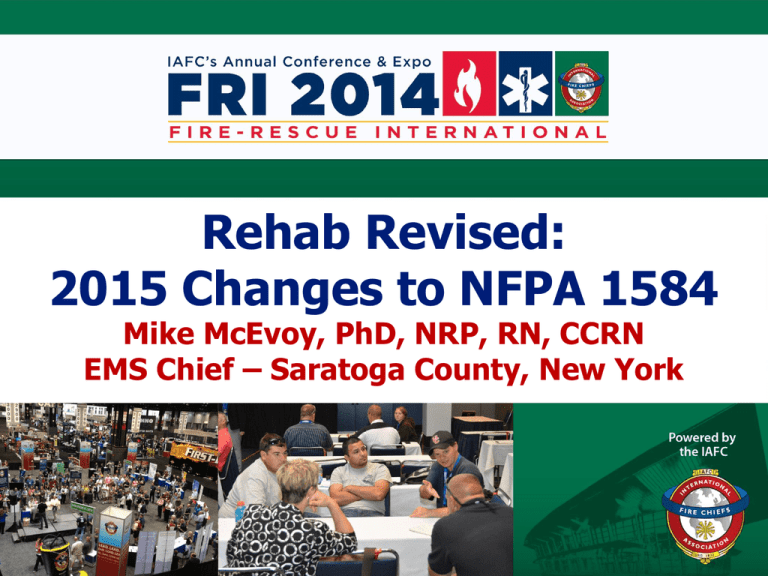
Rehab Revised: 2015 Changes to NFPA 1584 Mike McEvoy, PhD, NRP, RN, CCRN EMS Chief – Saratoga County, New York Rehab Revised: 2015 Changes to NFPA 1584 Mike McEvoy, PhD, NRP, RN, CCRN EMS Chief – Saratoga County, NY EMS Editor – Fire Engineering magazine Board Member – IAFC EMS Section www.mikemcevoy.com Rehab Resources www.firerehab.com Disclosures • I am on the speakers bureau for Masimo Corporation • I do not intend to discuss any unlabeled or unapproved uses of drugs or products McEvoy’s Philosophy: • Creation of 1584 (2008 version) – Prescriptive – Evidence basis McEvoy’s Philosophy: • Creation of 1584 (2008 version) – Prescriptive – Evidence basis • Real world rehab – Historical perspective (baggage) » Who needs it? McEvoy’s Philosophy: • Creation of 1584 (2008 version) – Prescriptive – Evidence basis • Real world rehab – Historical perspective (baggage) » Who needs it? » Effect on manpower / personnel pool @ scene McEvoy’s Philosophy: • Creation of 1584 (2008 version) – Prescriptive – Evidence basis • Real world rehab – Historical perspective (baggage) » Who needs it » Effect on manpower / personnel pool @ scene – Firefighters = adults = performance athletes NFPA Rehab Standard • Comment period open through 11/15/2013 • www.nfpa.org/1584 But we’re adults… Firefighters should know as much as professional athletes about rest, hydration, and endurance. But we’re adults… Firefighters should know as much as professional athletes about rest, hydration, and endurance. Firefighting • Greatest short surge physiologic demands of any profession. • 10% firefighter time spent on fireground 50% of deaths & 66% of injuries occur on scene. Firefighter LODDs – Likely Culprits: Medical condition Fitness Rehab What is Rehab? • “Restore condition of good health” • Mitigate effects of physical & emotional stress of firefighting: – – – – Sustain or restore work capacity Improve performance Decrease injuries Prevent deaths Firefighter Rehab – NFPA 1584 • National Fire Protection Association 1584 “Standard on the Rehabilitation Process for Members During Emergency Operations and Training Exercises” • Originally issued in as recommendation in 2003, became a Standard in 2008, revision due for release in 2015. • Every department responsible to develop and implement rehab SOGs Elements of Compliance • SOGs outline how rehab will be provided at incidents and training exercises (where FF expected to work 1 hour or more) • Minimum BLS level equipment on scene (= ambulance equipment) • Integrated into IMS Elements of Compliance • SOGs outline how rehab will be provided at incidents and training exercises (where FF expected to work 1 hour or more) Commence whenever potential safety or health risk to members or risk exceeds safe level of physical or mental endurance. NFPA 1584: 2015 Revisions Roles and Responsibilities delineated: • IC • CO • Rehab Manager • Members (FF) NFPA 1584: 2015 Revisions Incident Commander: • Establish rehab • Assure staffing & supplies • Rotate members • Mental health services available to all members • If crew member seriously injured or killed, remove all crew members as soon as possible NFPA 1584: 2015 Revisions Company Officer: • Awareness of FF physical/mental condition • Assure hydration • Assess his/her company every 45 min • Wildland: evaluate heat stress conditions NFPA 1584: 2015 Revisions Rehab Manager: • Operation, supplies • Food • Release • Records NFPA 1584: 2015 Revisions Member: • Use rehab • Hydrate • Advise CO when performance affected • Awareness of others NFPA 1584: 2015 Revisions Science Updates: • De-emphasis on sports drinks • Caffeine permitted up to 400 mg/day • Energy drinks banned • Passive cooling before active • Medical monitoring parameters are a local decision Hydration and Prehydration • Firefighters are often dehydrated • Prehydrate for planned activities: – 500 ml fluid within 2 hours prior to event • Hydrate during events: – Water appropriate most of the time – Sports drinks after first hour of intense work or 3 hours total incident duration • Best to consume small amounts (60-120 ml) very frequently - Typical gastric emptying time limits fluid intake to no more than 1 liter per hour. Hydration and Prehydration • Firefighters are often dehydrated • Prehydrate for planned activities: – 500 ml fluid within 2 hours prior to event • Hydrate during events: – Fluids: consume regardless of thirst, continue post incident – Sports drinks offered, consumed at FF discretion – Goal of completely replacing sweat loss deleted • Best to consume small amounts (60-120 ml) very frequently Sports Drinks • Usually contain electrolytes and carbohydrates • Osmolarity (concentration) formulated for maximal absorption • Absorption limited by gastric emptying time (COH) • Dilution will extend gastric emptying time and lead to nausea / vomiting Sports Drink Investigation • BMJ investigative report – 1035 web pages (listed in magazine ads), 431 performance-enhancing claims on 104 different products – 47.2% had references, none referred to systematic reviews (level 1 evidence) – 84% judged at high risk of bias – Only 3 (of 74) studies judged to be high quality and low risk of bias Heneghan C, Howick J, O’Neill B, Gill PJ, et al. The evidence underpinning sports performance products: a systematic assessment. BMJ Open 2012; 2:e001702. doi:10.1136/bmjopen-2012-001702 Sports Drink Investigation Energy Drinks Definition: “A type of beverage containing stimulant drugs (caffeine, and other ingredients such as taurine, ginsign, guarana) that is marketed as providing mental or physical stimulation.” Not to be confused with Sports Drinks NFPA 1584 - Overview 1. Ongoing education on when & how to rehab. 2. Provide supplies, shelter, equipment, and medical expertise to firefighters where and when needed. 3. Create a safety net for members unwilling or unable to recognize when fatigued. Who’s Responsible for What? • Department: develop and implement SOGs • Company Officer: – Assess his/her crew every 45 minutes – Suggested after 2nd 30-min SCBA bottle – Or single 45- or 60-min bottle – Or after 40 min intense work without SCBA • Company Officers can adjust time frames to suit work or environmental conditions What about informal rehab? • Was acceptable previously, now encouraged, particularly 1st round • Company or crew level rehab: – SCBA cylinder changes – Work transitions (firefighting to overhaul) – Small or routine incidents – When IC fails to recognize need for rehab Informal Rehab Requirements: 1. Fluids 2. Shelter 3. Place to remove PPE 4. Seating for members Nine Key Components of Rehab 1. Relief from climatic conditions 2. Rest and recovery 3. Cooling or rewarming 4. Re-hydration 5. Calorie and electrolyte replacement 6. Medical Monitoring 7. EMS tx according to local protocols 8. Member accountability 9. Release 1. Relief from Climatic Conditions An area free from smoke and sheltered from extreme heat or cold is provided 1. Relief from Climatic Conditions • Rehab unit or air conditioned vehicle/room • Portable heaters, enclosed unit • Removed, but not too far from incident • Vestibule area for removal and storage of PPE 2. Rest and Recovery • Members afforded ability to rest for at least 10 minutes or as long as needed to recover work capacity 2. Rest and Recovery • If not rested, rest for 10 more minutes. • Rest 20 min. on second rehab 3. Cooling or Rewarming Better definition 1. Shaded or air conditioned area 2. Remove PPE – Gloves, helmet, hood, coat, open bunker pants (pull down to knees when seated) 3. Cool fluids 4. Rest 3. Cooling or Rewarming • Passive cooling initially • Active cooling when passive ineffective or member exhibits heat related illness Active Cooling: Cold Drinks • Cold Drinks – Serves dual purpose of hydration and cooling • Ability to cool may be limited on scene – Drinks usually stored warm - must be cooled or only benefit is hydration Cold Towel – 3 Bucket System • Bucket 1: sanitizing solution – ¼ cup bleach/gallon • Bucket 2: rinse – Clear water removes any left over bleach • Bucket 3: regeneration – Ice water restores cooling effect 4. Re-hydration • Potable fluids to satisfy thirst on scene • Guidelines on beverages revised to allow caffeine up to 400 mg per day and prohibit energy drinks 4. Re-hydration The truth about caffeine: • Increases urine output • Does not usually dehydrate (compensatory decline) • Consumption < 400 mg appears safe for firefighters • Reference: EFO paper Stephen Abbott: Assessing the effect of energy drinks on firefighter health and safety www.usfa.fema.gov/pdf/efop/efo45842.pdf 4. Re-hydration • Fluid losses will often exceed gastric emptying limitations • No reliable method of assessing hydration status on scene – Weights – Urine specific gravity – ? Saliva testing 4. Re-hydration Encourage continued hydration post-incident 5. Calorie and electrolyte replacement • Rather than time (3+ hour event), now consider duration, exertion, time of last meal and individual conditions. • Whenever food is available, means to wash hands and faces must also be provided. Food • Fruits, meal replacement bars, carbohydrate drinks (15 gm COH) • 30-60 grams carbohydrate per hour • High fat foods inappropriate Medical Monitoring vs. Emergency Care Medical monitoring: observing members for adverse health effects (physical stress, heat or cold exposure, environmental hazards) Emergency Care: treatment for members with adverse effects or injury. 6. Medical Monitoring in Rehab 6. Medical Monitoring in Rehab Specifies minimum 6 conditions be screened: 1. CP, dizzy, SOB, weakness, nausea, h/a 2. General c/o (cramps, aches, pains…) 3. Sx heat or cold-related stress 4. Changes in gait, speech, behavior 5. Alertness and orientation x 3 6. Any VS considered abnormal locally 6. Medical Monitoring in Rehab Local (FD) medical monitoring protocols: 1. Immediate EMS treatment and transport 2. Close monitoring in rehab area 3. Release 6. Medical Monitoring in Rehab • Vital signs now required: (For all members entering rehab) – Temperature – Heart rate – Respiratory rate – Blood pressure – Oxygen saturation • Members exposed to fire smoke shall be assessed for CO poisoning Vital Sign Parameters • NFPA 1584 Annex includes suggested vital sign parameters • Each department must: – Set vital sign parameters – Specify if and when reassessment of vital signs should occur Vital Signs • Many departments do not measure • No evidence or published studies: – Determine when treatment necessary – Predict type or duration of rehab needed • Vitals may help set parameters for monitoring, treatment, transport, release • Must be evaluated in context Temperature • Core temp most accurate – NL = 98.6-100.6°F (37-38.1°C) – Best measured rectally or temp transmitter • Oral or tympanic used in field – Oral 1°F (0.55°C), tympanic 2°F (1.1°C) less • Errors common in measuring firefighters – Oral falsely low from rapid resps or fluid consumption – Tympanic less accurate with significant environmental influences (hot/cold) Pulse • NL = 60-80, many influences. • Very important to interpret in context of individual. • Recovery rate may be more significant than actual heart rate. • If > 100 after 20 min rest, further eval needed before release • Pulse ox offers accurate measure Respiratory Rate • NL = 12 – 20, should with fever and exercise • Should return to normal with rest Blood Pressure • • • • Most measured Least understood Very contextual Tremendous potential for error Blood Pressure Sources of error: 1. Cuff size 2. Arm placement 3. NIBP Potential for cross contamination: - Need to decon between each use Blood Pressure • NFPA suggests members with SBP > 160 or DBP > 100 not be released from rehab. Mike McEvoy editorial commentary: • Several studies have suggested hypotension (SBP < 80) may be of far greater concern than high blood pressure during rehab. Pulse Oximetry • Non-invasive measurement of oxygen and blood flow • NL = 95-100% • Most oximeters cannot differentiate oxyhemoglobin from carboxyhemoglobin • Members with SpO2 < 92% should not be released from rehab CO Assessment • Carbon monoxide is present at all fires and a leading cause of death • CO monitoring during rehab has become standard of care • Exhaled CO meter or pulse COOximeter are two detection devices Carbon Monoxide Smoke Characterization Study www.ul.com Smoke Characterization Study Live Fire Study • Chicago Fire Dept. – February through May, 2009 • Rescue Squad Company No. 5 • 44 fires (40 residential and 4 commercial) • Measurements during all phases of fire through overhaul: – Air monitoring (direct air monitoring and personal monitors) – Measurement of smoke particle sizes and content – Gloves and hoods sent to lab for analysis Peak Gas Concentrations at Fires Max (ppm) Mean (ppm) HCN NH3 SO2 NO2 H2S NIOSH – IDLH (ppm) 50 300 100 20 100 30.0 4.0 150.0* 2.3 133.9 7.0 1.8 31.0* 0.7 18.4 CO 1200 1500* 774* Gas * sensor limited values – true values would be higher Total Gas Concentrations at Fires Gas HCN NH3 SO2 NO2 H2S CO NIOSH STEL (ppm) 4.7 35 5 1 10a 200a TWA (ppm) Mean (ppm) 10b 25 2 5b 10 35 27.4 8.8 200.2* 0.9 146.2 5,313* a 10 minute exposure limits b OSHA limit (in general, NIOSH limits are more conservative) * sensor limited values – true values would be higher Firefighter Health: the Obvious New Fire Ground CO Study • Sacramento Fire: September 2010 through June 2011 • Baseline SpCO at start of each shift for every firefighter • Remeasured at conclusion of overhaul, apparatus position noted • 48 fires with 201 paired measurements – Baseline 1.0 + 1.6% No difference – Following overhaul 1.2 + 1.6% p = 0.1408 • 10 occurrences of SpCO > 5% after overhaul Mackey K, Filbrun T, Schatz D, Hostler D, Ogan L. Do carbon monoxide levels rise in firefighters during overhaul operations following a structure fire? [Abstract]. Prehosp Emerg Care 2012; 16:153-154. IAFF Statement January 2008 Routine testing of any firefighter potentially exposed to CO using a COoximeter Firefighter Rehab Cyanide • Consider at all fire scenes • All patients in cardiac arrest • Any patient in shock, especially if low CO level • Treat with cyanide antidote kit Paris Fire Brigade ROSC = 50% 7. EMS Tx according to local protocol Documentation changes • Rehab log minimum: 1. 2. 3. 4. Unit # Member name Time in and out Disposition • When EMS Tx given, defer to HIPAA and local laws, rules, regs NFPA Sample Rehab Log 8. Member Accountability • Track members assigned to rehab • IC must know whereabouts (i.e.: when they enter rehab and when they leave) 9. Release • Prior to leaving rehab, EMS must confirm that members are able to safely perform full duty. Wildland Firefighter Rehab • Placeholder inserted • Potential concerns: – Acclimatization, hydration, hourly assessment of environmental conditions (includes wet bulb globe temp to alter work/rest cycle to prevent heatrelated illness) Rehab Research Needed… Thanks for your attention! www.mikemcevoy.com LEAD. EDUCATE. SERVE. 86


